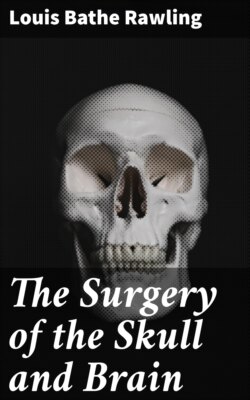Читать книгу The Surgery of the Skull and Brain - Louis Bathe Rawling - Страница 53
На сайте Литреса книга снята с продажи.
TRAUMATIC CEPHALOCELES
ОглавлениеTable of Contents
Many cases have been recorded in which a cephalocele developed after an injury to the skull. In such conditions it is necessary that a comminuted or fissured fracture of the vault should be present, that the underlying dura mater should be torn, and that the adjacent brain substance should be severely contused or lacerated. Cerebro-spinal fluid may alone escape through the gap in the skull to the subaponeurotic and subcutaneous regions, leading to the formation of a false traumatic meningocele. When the brain shares in the outward protrusion the condition is known as false traumatic meningo-encephalocele. This protrusion of the brain is dependent on the fact that the injury—necessarily a severe one—leads to considerable brain lesion, with subsequent œdema and localized or general increase in the intracranial pressure.
Occasionally, the external accumulation of cerebro-spinal fluid communicates with one of the horns of the lateral ventricle. A meningo-encephalocele, having such connexions, is produced in the following manner:—the protruded brain includes that part of the cerebral substance which bounds one of the horns of the lateral ventricle, usually the descending cornu. The ventricular channel becomes elongated in the outward direction, towards and through the gap in the skull, whilst the increased intraventricular tension gradually dilates up the new channel, and, in course of time, still further spreads out and thins that part of its cerebral boundary which lies external to the skull deficiency.
There can be no question that after the patient has reached the age of three years traumatic cephaloceles are of exceedingly rare occurrence. This special liability in quite young children has been ascribed to the greater elasticity of the infant skull, and to the supposed greater adherence of the dura mater. Though these factors may exercise some influence on the production of the tumour, it seems more probable that the development of a cephalocele is dependent to a greater degree on the general vitality of the child. Thus, a blow that produces in the adult a comminuted or widely fissured fracture of the skull, with laceration of the dura mater and injury to the underlying brain, frequently leads to a fatal result, whilst the child often recovers. Again, in the adult, the force required to produce such a lesion usually suffices to lacerate the integument. Consequently a compound comminuted fracture of the vault with hernia cerebri is relatively more common in the adult than in the infant.
The right side of the head is more frequently affected than the left, and, of all bones in the skull, the parietal is the one most constantly involved.
